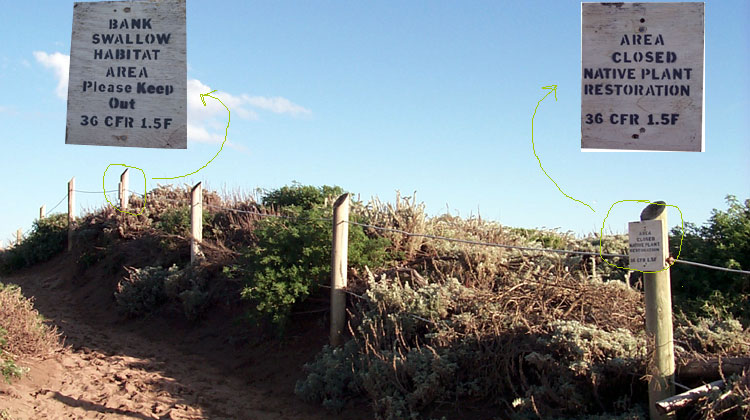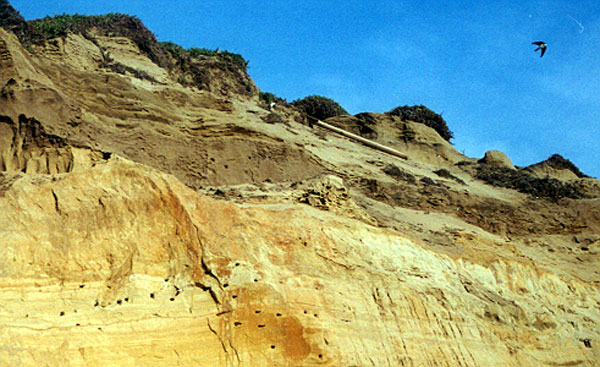Here's a re-run of last year's Earth Day issue
...
Fort Funston Forum Earthday,
April 22, 2000 
Earth Day Editorial:
Where's the Science? by
Michael B. Goldstein
Ecology:
The science of the relationships between
organisms and their environments.
[The
American HeritageŽ Dictionary of the English Language, Third Edition]
Protecting the environment depends on
good science. Good intentions aren't enough. "Common sense" ideas
about cause and effect are often not true. The Law of Unintended Consequences
means that the best laid plans often end up backfiring. And these mistakes
can have a ripple effect, throwing an entire ecosystem out of balance.
That is why it is troubling to see how
the National Park Service has approached the ecology of Fort Funston. In the
current bank swallow debate, many dog owners and others would have been willing
to accept major restrictions on land use if valid scientific studies had been
presented for review in a public forum. But we had neither studies nor forum.
Instead, and mostly through a federal
lawsuit, we found a history of changing rationales for one land closure after
another.
The '95 northern closure was for the bank
swallow habitat. But the swallows don't go there anymore. If you go there, you'll
see these signs, just thirty feet apart (photo: April 17th.)
One cites the bank swallow habitat; the other, native plant restoration.

The two are related, of course;
everything's related in the environment. One claim has been that, by keeping
people and dogs out of the new, "permanent" closure area, ripping
out the existing ice plant and planting so-called native plants, this will
help the bank swallows. It's reasoned that, even though the bank swallows
feed on insects primarily at Lake Merced, introducing new native plants
would increase biodiversity, thereby increasing the insect count and helping
provide supplemental food for the bank swallows.
A wide swath of land, many acres
more than simply the cliffs, has been completely closed to recreational use
half the year (the "seasonal" closure area) in the name of bank
swallow habitat protection but with virtually no scientific justification.
Then there was the other '95
closure, the hillside between Battery Davis and the beach access route near
the base of the "loop". This closure was also done in the name of
native plant restoration, and was then to be reopened in five years. However,
whatever the rationale for the planting, it never happened and that land has
recently had its signs changed to read, "Closed for Your Safety,"
with no further details.
Finally, the Sunset Trail was
abruptly closed for months and only reopened partially (still closed to those
who can't traverse its now unpaved and uneven sandy surfaces) after a firestorm
of protest. No scientific studies were put forth by the Park Service, which
claimed later that much of the route was unsafe pavement, not documented,
to justify what appeared to many to be an outright falsehood. An April 5th
letter to the GGNRA from the chair of the Conservation Committee of the Golden
Gate Audubon Society recommends closure of that zone as well, claiming that
erosion from usage is a threat to the adjacent cliffs. Again, little in the
way of verifiable evidence to back up such claims.
Combined, these five zones represent
the vast majority of the coastal bluffs of Fort Funston. How would the environment,
which includes humans and dogs, be impacted by such a severe closure? Where
are the assumptions, hypotheses, predictions, criteria, controlled experiments,
data from observation, results, interpretations, and repeatability that would
be the foundation of valid scientific studies of Fort Funston's ecology?
Fort Funston is not an island;
it's part of a system. That system, the National Park Service, is run by administrators
who, according to an article in Science magazine this month
[ 1. ] ,
"have tended to view
science with anything from benign neglect to outright hostility. The result
has been a number of decisions that have been slammed by scientists, challenged
in court, and even debated in Congress..."
Later, the article states,
"A 1992 study by the National Academy
of Sciences, for instance, found that 'almost invariably... management
of the parks was done with inadequate understanding of ecological systems.'
And the science that has been done has often been manipulated to support
policy, critics allege. Park managers 'have very carefully controlled
the actual research that's done and the reporting of that research,' says
ecologist Fred Wagner of Utah State University in Logan, citing studies
of elk and grizzly bears in Yellowstone National Park.".
and, although a reform program
is being launched, In the event that valid
scientific studies of Fort Funston's ecology are conducted, Fort Funston Forum
will attempt to obtain and publish these for public review and discussion. In
addition, Fort Funston Forum will be adding links to sites with relevant science.
The initial focus will be on the bank swallows, the visiting species which has
survived much heat but little light in Fort Funston's current environment.
[ 1. ] "Bringing
Science to the National Parks" by Jocelyn Kaiser, SCIENCE,
7 April 2000, p. 34.

Hawks and other predators swoop
down and devour hatchlings waiting at the entrance to their burrows for their
parents to return with food. This is a part of nature's course, but since
the bank swallows are a threatened species (although not
an endangered species as stated on Park Service signs put up
with the seasonal closure on April 12th) efforts may be made to discourage
this activity. It's possible that human and dog activity in the now closed
area would reduce the birds of prey's numbers and thereby help protect the
bank swallow habitat. Research (2) found adjacent
land use common and not generally harmful to bank swallow colonies. The post
just below the top of the cliffs is one of dozens of damaged or destroyed
fenceposts and signs, previous years' attempts to protect the bank swallows,
which the Park Service has neglected to maintain while going forward with
a much more costly and controversial closure plan this year.
Comments on this Earthday
Editorial? Please click
here to send an e-mail message!
Fort Funston Forum is an
independent publication. The opinions expressed are those of the editor
and identified writers, and are specifically not presented here as
the opinions of any other person or organization involved with current issues
at Fort Funston. ***** Michael B. Goldstein, Editor


